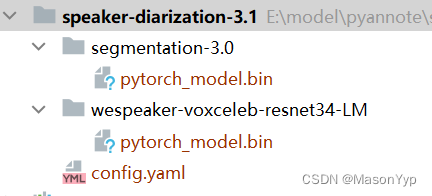用vs做购物网站网络营销与直播电商专升本
使用pyannote-audio实现声纹分割聚类
# GitHub地址
https://github.com/MasonYyp/audio
1 简单介绍
pyannote.audio是用Python编写的用于声纹分割聚类的开源工具包。在PyTorch机器学习基础上,不仅可以借助性能优越的预训练模型和管道实现声纹分割聚类,还可以进一步微调模型。
它的主要功能有以下几个:
- 声纹嵌入:从一段声音中提出声纹转换为向量(嵌入);
- 声纹识别:从一段声音中识别不同的人(多个人);
- 声纹活动检测:检测一段声音检测不同时间点的活动;
- 声纹重叠检测:检测一段声音中重叠交叉的部分;
- 声纹分割;将一段声音进行分割;
pyannote.audio中主要有”segmentation“、”embedding“和”speaker-diarization“三个模型,”segmentation“的主要作用是分割、”embedding“主要作用是嵌入(跟wespeaker-voxceleb-resnet34-LM作用相同),”speaker-diarization“的作用是使用管道对上面两个模型整合。
pyannote-audio的参考地址
# Huggingface地址
https://hf-mirror.com/pyannote# Github地址
https://github.com/pyannote/pyannote-audio
⚠️ 注意: pyannote.audio不同的版本有些区别;
2 使用pyannote.audio:3.1.3
2.1 安装pyannote.audio
pip install pyannote.audio==3.1.1 -i https://pypi.tuna.tsinghua.edu.cn/simple
使用模型需要现在huggingface上下载模型,模型如下:
⚠️ pyannote.audio的部分模型是收到保护的,即需要在huggingface登录后,填写部分信息,同意相关协议才能下载,否则无法下载。
# 1 嵌入模型 pyannote/wespeaker-voxceleb-resnet34-LM
https://hf-mirror.com/pyannote/wespeaker-voxceleb-resnet34-LM# 2 分割模型 pyannote/segmentation-3.0
https://hf-mirror.com/pyannote/segmentation-3.0
使用huggingface-cli下载相关模型的命令:
# 注意:需要先创建Python环境# 安装huggingface-cli
pip install -U huggingface_hub# 例如下载pyannote/embedding模型
# 必须提供Hugging上的 --token hf_****
huggingface-cli download --resume-download pyannote/embedding --local-dir pyannote/embedding --local-dir-use-symlinks False --token hf_****
注意两个类
# Inference主要用于声纹嵌入
pyannote.audio import Inference# Annotation主要用于声纹分割
from pyannote.core import Annotation# Annotation中的主要方法,假设实例为;diarization
# 获取声音中说话人的标识
labels = diarization.labels()# 获取声音中全部的活动Segment(列表)
segments = list(diarization.itertracks())# 获取声音中指定说话人时间段(列表),”SPEAKER_00“为第一个说话人的标识
durations = diarization.label_timeline('SPEAKER_00')
2.2 实现声纹分割
注意:pyannote/speaker-diarization-3.1实现声纹识别特别慢,不知道是不是我的方法不对(30分钟的音频,处理了20多分钟)。⚠️ 使用单个模型很快。pyannote/speaker-diarization(版本2)较快,推荐使用pyannote/speaker-diarization(版本2)。
注意:此处加载模型和通常加载模型的思路不同,常规加载模型直接到名称即可,此处需要加载到具体的模型名称。
(1)使用python方法
# 使用 pyannote-audio-3.1.1
import timefrom pyannote.audio import Model
from pyannote.audio.pipelines import SpeakerDiarization
from pyannote.audio.pipelines.utils import PipelineModel
from pyannote.core import Annotation# 语音转向量模型
embedding: PipelineModel = Model.from_pretrained("E:/model/pyannote/pyannote-audio-3.1.1/wespeaker-voxceleb-resnet34-LM/pytorch_model.bin")
# 分割语音模型
segmentation: PipelineModel = Model.from_pretrained("E:/model/pyannote/pyannote-audio-3.1.1/segmentation-3.0/pytorch_model.bin")# 语音分离模型
speaker_diarization: SpeakerDiarization = SpeakerDiarization(segmentation=segmentation, embedding=embedding)# 初始化语音分离模型的参数
HYPER_PARAMETERS = {"clustering": {"method": "centroid","min_cluster_size": 12,"threshold": 0.7045654963945799},"segmentation":{"min_duration_off": 0.58}
}
speaker_diarization.instantiate(HYPER_PARAMETERS)start_time = time.time()# 分离语音
diarization: Annotation = speaker_diarization("E:/语音识别/数据/0-test-en.wav")# 获取说话人列表
print(diarization.labels())
# 获取活动segments列表
print(list(diarization.itertracks()))
print(diarization.label_timeline('SPEAKER_00'))ent_time = time.time()
print(ent_time - start_time)
(2)使用yml方法
# instantiate the pipeline
from pyannote.audio import Pipeline
from pyannote.core import Annotationspeaker_diarization = Pipeline.from_pretrained("E:/model/pyannote/speaker-diarization-3.1/config.yaml")# 分离语音
diarization: Annotation = speaker_diarization("E:/语音识别/数据/0-test-en.wav")print(type(diarization))
print(diarization.labels())
config.yaml
根据文件可以看出,声纹分割是将embedding和segmentation进行了组合。
version: 3.1.0pipeline:name: pyannote.audio.pipelines.SpeakerDiarizationparams:clustering: AgglomerativeClustering# embedding: pyannote/wespeaker-voxceleb-resnet34-LMembedding: E:/model/pyannote/speaker-diarization-3.1/wespeaker-voxceleb-resnet34-LM/pytorch_model.binembedding_batch_size: 32embedding_exclude_overlap: true# segmentation: pyannote/segmentation-3.0segmentation: E:/model/pyannote/speaker-diarization-3.1/segmentation-3.0/pytorch_model.binsegmentation_batch_size: 32params:clustering:method: centroidmin_cluster_size: 12threshold: 0.7045654963945799segmentation:min_duration_off: 0.0
模型目录
模型中的其他文件可以删除,只保留”pytorch_model.bin“即可。

执行结果

2.3 实现声纹识别
比较两段声音的相似度。
from pyannote.audio import Model
from pyannote.audio import Inference
from scipy.spatial.distance import cdist# 导入模型
embedding = Model.from_pretrained("E:/model/pyannote/speaker-diarization-3.1/wespeaker-voxceleb-resnet34-LM/pytorch_model.bin")# 抽取声纹
inference: Inference = Inference(embedding, window="whole")# 生成声纹,1维向量
embedding1 = inference("E:/语音识别/数据/0-test-en.wav")
embedding2 = inference("E:/语音识别/数据/0-test-en.wav")# 计算两个声纹的相似度
distance = cdist([embedding1], [embedding2], metric="cosine")
print(distance)
2.4 检测声纹活动
from pyannote.audio import Model
from pyannote.core import Annotation
from pyannote.audio.pipelines import VoiceActivityDetection# 加载模型
model = Model.from_pretrained("E:/model/pyannote/speaker-diarization-3.1/segmentation-3.0/pytorch_model.bin")# 初始化参数
activity_detection = VoiceActivityDetection(segmentation=model)
HYPER_PARAMETERS = {# remove speech regions shorter than that many seconds."min_duration_on": 1,# fill non-speech regions shorter than that many seconds."min_duration_off": 0
}
activity_detection.instantiate(HYPER_PARAMETERS)# 获取活动特征
annotation: Annotation = activity_detection("E:/语音识别/数据/0-test-en.wav")# 获取活动列表
segments = list(annotation.itertracks())
print(segments)
3 使用pyannote.audio:2.1.1
⚠️ 推荐使用此版本
3.1 安装pyannote.audio
# 安装包
pip install pyannote.audio==2.1.1 -i https://pypi.tuna.tsinghua.edu.cn/simple# 1 嵌入模型 pyannote/embedding
https://hf-mirror.com/pyannote/embedding# 2 分割模型 pyannote/segmentation
https://hf-mirror.com/pyannote/segmentation
3.2 实现声纹分割
# 使用 pyannote-audio-2.1.1
import timefrom pyannote.audio.pipelines import SpeakerDiarization
from pyannote.audio import Model
from pyannote.audio.pipelines.utils import PipelineModel
from pyannote.core import Annotation# 语音转向量模型
embedding: PipelineModel = Model.from_pretrained("E:/model/pyannote/pyannote-audio-2.1.1/embedding/pytorch_model.bin")# 分割语音模型
segmentation: PipelineModel = Model.from_pretrained("E:/model/pyannote/pyannote-audio-2.1.1/segmentation/pytorch_model.bin")# 语音分离模型
speaker_diarization: SpeakerDiarization = SpeakerDiarization(segmentation=segmentation,embedding=embedding,clustering="AgglomerativeClustering"
)HYPER_PARAMETERS = {"clustering": {"method": "centroid","min_cluster_size": 15,"threshold": 0.7153814381597874},"segmentation":{"min_duration_off": 0.5817029604921046,"threshold": 0.4442333667381752}
}speaker_diarization.instantiate(HYPER_PARAMETERS)start_time = time.time()
# vad: Annotation = pipeline("E:/语音识别/数据/0-test-en.wav")
diarization: Annotation = speaker_diarization("E:/语音识别/数据/0-test-en.wav")# 获取说话人列表
print(diarization.labels())ent_time = time.time()
print(ent_time - start_time)
3.3 其他功能
3.1.1版本的功能2.1.1都能实现,参考3.1.1版本即可。
